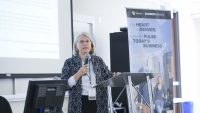
The J.P. Morgan Center for Commodities (JPMCC) New Directions in Commodities Research international symposium brought together the business community and leading academic researchers. From August 13-15, over 80 top researchers and practitioners congregated in Denver from across the world to discuss the most pressing issues facing industries with commodities exposure.

Global thought leaders and prominent stakeholders in the industry shared new work that focused on the real-world relevance of commodities research, specifically oriented to the immediate and near-term future. Policymakers from the US Federal Reserve Board, Bank of Canada, and US Energy Information Administration, as well as industry leaders from companies such as CME, J.P. Morgan, CoBank, Bain Capital, and Robert Bosch were in attendance.
The seven sessions were limited to outstanding research comprised of 18 competitively selected papers and solicited panel discussion from both academic and practitioner communities. Submitted papers were selected by the Program Committee consisting of members of the JPMCC’s Research Council.
The movers and shakers of global commodities
As part of the symposium’s inception, James Hamilton of the National Bureau of Economic Research (NBER) and professor at the University of California at San Diego was excited to return as a session chair and discussant. With work published not only on top economics journals such as American Economic Review (AER), Journal of Political Economy (JPE), and Econometrica, but also on top finance journals such as The Review of Financial Studies (RFS), Hamilton is considered one of the best-known econometricians and perhaps the top energy economist in the world.
Hamilton was joined by other keynote and session speakers including:
- “Agricultural Commodities, Business Cycles and Drivers of Volatility” Terry N. Barr Senior Director, Knowledge Exchange Division, CoBank ACB
- “Macroeconomic Determinants of International Commodity Prices” Jeffrey Frankel, James W. Harpel Professor of Capital Formation and Growth, Harvard University
- “Expected Risk-Return Probability Distributions: Important Differences between Commodity and Financial Markets” Bluford Putnam Managing Director & Chief Economist, CME Group
- “What Drives Success in Derivatives Markets?” Robert I. Webb, Martin J. Patsel Jr. Research Professor, University of Virginia; Editor, Journal of Futures Markets
Jeffrey Frankel, Harvard Professor, a former Director of the International Finance and Macroeconomics program at the NBER, and a former Chief Economist of the US President’s Council of Economic Advisors, presented one of two keynote addresses entitled “Macroeconomic Determinants of International Commodity Prices.”
In this timely address, he acknowledged that although price movements of different commodities are sometimes unrelated, there is a correlation between commodities because of macroeconomic forces at play. Several of those factors included economic activity (GDP), monetary policy (real interest rate), exchange rates, and other determinants of net convenience yield.
The causes and effects of commodity prices
Eric Reiner, CU Denver Professor of Finance, recently contributed to Financial Advisor Magazine on the topics examined at the JPMCC Symposium. Specifically, he discussed the delayed reaction that oil-price shocks have on stock prices.
Hamilton, after looking at oil price shocks occurring as far back as the 1940’s, found that when oil skyrockets, the economy often stumbles not long thereafter. He used the auto industry as an example sector that suffers.
“[Hamilton] attributed part of the dip in U.S. gross domestic product during the Financial Crisis to the oil price surge that occurred between mid-2007 and mid-2008,” Reiner recalled.
Frankel’s address also touched on this topic. An expanding economy brings greater demand, and hence higher prices for industrial metals, energy, and other raw materials. Ultimately, “some of the big price swings since 2000 can be explained by GDP,” Frankel noted, “but there is more going on.”
Frankel said that an increase in the real interest rate has a negative effect on real commodity prices when controlling for GDP. According to over 30 years of research, Frankel found that “changes in the real (after-inflation) rate of interest also impact commodity prices, and the relationship is inverse. Higher rates, for example, make it more expensive for businesses to carry inventory, so they sell down their inventory, which drives commodity prices [from oats to copper to cattle] lower,” Reiner shared.
The value of the dollar is also a player in the game. “When the dollar depreciates, internationally-traded items such as commodities become more expensive in dollars. The opposite occurs when the dollar gains in value,” Frankel said.
“I see real commodity prices going down the next few years,” Frankel concluded. As the Fed continues to tighten, interest rates and the dollar’s strength will rise, leading to lower commodity prices.
The rich data on floating oil
Andrei Kirilenko, the Director of the Center for Global Finance and Technology at the Imperial College Business School in London, and his co-author Anna Kruglova of the University of Washington, won this year’s best paper award for their work “Speculative Floating Oil.” They impressed the committee with their novel data set and creative research design to walk away with the 2,000-dollar prize.
The paper brought together oil prices, volatility, and futures prices into one comprehensive framework.
Carry traders are assumed to have access to a market for off-shore storage technology. The research showed that in equilibrium, arbitrage activities of cash-and-carry traders are linked with the risk premium in commodity prices and the cost of floating storage. Kirilenko and Kruglova tested empirical predictions of their model using data with granular information on every tanker that delivered seaborne crude oil into the United States during 2008-2012. Their results were consistent with the predictions of the model.
“This conference has become the global place for thought leaders and commodities to come together and present their views,” Kirilenko commented. “There is a great foundation because the [J.P. Morgan] Center for Commodities serves as an educational platform on which it can build and exchange ideas. People came from all over to talk about their work. I have been in this field for a long time and can tell you the quality of papers and presentations and presenters is world-class.”
Valuable industry-focused solutions as the focus
The model that JPMCC created for the symposium was reliant on both academic researchers and practitioners. The entire team felt strongly that both groups offered something different to the other, “allowing us to understand what big questions need answering and how to find the data to create those solutions. I like to see things with rigorous data that people can talk about,” Hamilton said.
Thorvin Anderson, a research council member for the JPMCC, was very interested to see how well these two groups would interact in this new setting. “It’s easy for academics to veer off from the industry and relevant questions. I think part of what the Center is trying to do is pull attention back to issues most urgently addressed.”
Although there are a few similar symposiums across the US, most focus entirely on energy or agriculture. Others gear themselves towards academics or the business community, but rarely both.
Hamilton is convinced that what makes New Directions shine is the broader context that involves people from both sides and different backgrounds to share ideas and research. “It’s all about connections,” Hamilton said. “Despite the internet, you can’t get everything you need just sitting at your desk.”
Kirilenko mirrored Hamilton’s sentiments. “I really liked the combination of presentations, discussions, and industry panels because you can learn so much from different people willing to share ideas. The keynote speakers were terrific because they really anchored your thoughts and brought the audience together.”
Global outreach
Jian Yang, Research Director of the JPMCC and the conference organizer, and his team worked hard to increase the international visibility of the symposium, especially to the business communities abroad. Almost every business touches on commodities in one way or another, but due to their complex and constantly evolving markets, there is a lack of deep understanding of how commodities function.
“We wanted to bring together global thought leaders and prominent stakeholders to discuss their critical thinking and new research related to the industry,” Yang said.
JPMCC’s goal is to create the type of research platform that can work easily alongside top organizations such as World Bank.
Most importantly was the successful outreach to the international academic and business communities. Participants and contributors of the symposium hailed from seven countries, including US, China, UK, Germany, Canada, Australia, and Poland. The symposium drew extensive participation from top institutions such as Harvard, Yale, Cornell, UC-Berkley, and Imperial College London; policymakers from the Federal Reserve Board, Bank of Canada, and EIA; and leading industry practitioners including chief economists from CME, Cobank, and Newmont Mining.
A success at home and abroad
 The success of the JPMCC symposium has also reached financial news media outlets in China. Yicai, a media outlet by the largest financial conglomerate in China, wrote a story covering the symposium. Futures Daily, another Chinese media outlet, also published a piece about the research presented at the symposium.
The success of the JPMCC symposium has also reached financial news media outlets in China. Yicai, a media outlet by the largest financial conglomerate in China, wrote a story covering the symposium. Futures Daily, another Chinese media outlet, also published a piece about the research presented at the symposium.
Liyan Han, a professor at Beihang University, thoroughly enjoyed the quality presentations and networking. “It is a top-level symposium for the field of energy and finance; the context and the topics very relevant.”
“We can especially understand the American way of thinking because we have different cultures and backgrounds and we share social systems,” Han added. “This helps us understand energy finance and management and the drives and big influential impact of this field.”
Yang and Rohan Christie-David, Dean of the CU Denver Business School, are very proud of the growth and reputation of the symposium and the platform the JPMCC is creating. Yang said, “Based on the feedback we received from many participants during the conference, there is no doubt that the success this year will breed more success in 2019.”
Photos by Patrick Campbell/University of Colorado















